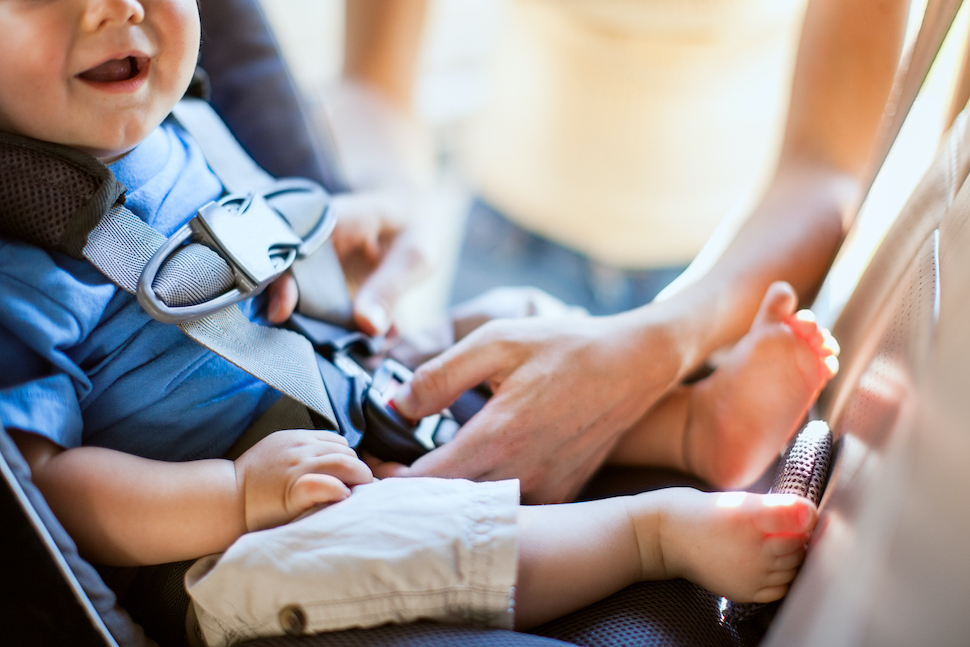Table of Contents
In a previous article, we reviewed three scientific studies on the safest position for a newborn’s car seat.
In summary and to quote the science:
“Unrestrained children in the front [seat] were at the highest risk of injury and appropriately restrained children in the rear were at the lowest risk, for all age groups.1”
And, since “40% of all of the crashes were side impacts [to the vehicle],2” children seated in the center rear had a “43% lower risk of injury compared with children in a rear outboard position.”3
Based on this science and information from reliable official sources, including What To Expect4, the Mayo Clinic5, and national car manufacturers6, we know the safest place for your newborn car seat and baby is in the middle of a rear seat.
But science also suggests yet another reason that the safest newborn car seat position is middle-rear, this one is related to EMF overexposure. (For more understanding of the subject in general, see also, 10 Scientific Studies on Cell Phone Use While Pregnant)
You’re probably wondering: How exactly do car tires have anything to do with my baby? Great question, and here’s your answer—
Steel Belted Radial Car Tires Generate Electromagnetic Fields
Steel-belted radial tires are standard issue in most modern vehicles. Built with a mile-long network of fine magnetic steel cord or wire7 woven into belts that run “radially” (out from the center) at a 90 degree angle to the tire’s direction of travel, these tires are safer, stronger, more flexible, longer lasting and reduce fuel consumption.8
They do, however, have a flaw of sorts worth mentioning: As that steel rotates around at anywhere from 1 to 70-plus miles per hour, it generates an electromagnetic field.
According to Samuel Milham, M.D. and MPH (Master of Public Health) and the author of more than 100 peer-reviewed articles, “Electromagnetic fields can be generated by spinning magnets, which is what steel-belted radial rotating tires are.”
“A child sitting in a baby seat over a rear tire could get a higher magnetic field exposure in an hour riding in the car than in twenty-four hours at home.” – Samuel Milham, M.D.
Study: Passengers Seated Near Rear Doors Have Higher EMF Exposures Than Passengers in Middle Rear
“Magnetic fields emanate from radial tires due to the presence of reinforcing belts which are made of magnetized steel wire.”9
“Since the generated magnetic fields drop off quickly with distance, vehicle geometry in reference to the tires will be a major factor in determining exposure of vehicle occupants. In the passenger compartment, fields are highest in places closest to the tires. In the two cars examined, fields are highest on the floor of the front seat near the doors and on the back seat near the doors.
“Passengers sitting near the doors on the rear seat will have higher exposures than passengers sitting in the middle of the rear seat by virtue of their distance from the rear tires.
“On a bus, seats directly over the rear wheels present the potential for higher exposures. Drivers in trucks with the driver’s seat directly over the front tires will have higher exposures than drivers in trucks with the front wheels well forward of the driver’s seat. The highest exposure of a left-seated passenger car driver will be to the left foot and lower leg.” [Emphasis added in bold] — Milham S, Hatfield JB, Tell R. Magnetic fields from steel-belted radial tires: implications for epidemiologic studies. Bioelectromagnetics. 1999;20(7):440-445.
Reduce EMF Exposure in Car
Aside from a standard seating plan that always safely places a baby in the middle rear seat, parents can further reduce their own and a child’s EMF exposure in a car by turning their cell phones off while driving (or placing them in airplane mode), choosing a vehicle with fewer electronic or remote control systems, smaller LCD displays and no built in WiFi router.10
References:
- Durbin, D. R., Chen, I., Smith, R., Elliott, M. R., & Winston, F. K. (2005). Effects of seating position and appropriate restraint use on the risk of injury to children in motor vehicle crashes. Pediatrics, 115(3), e305–e309. https://doi.org/10.1542/peds.2004-1522
- Sherwood, C. P., Ferguson, S. A., & Crandall, J. R. (2003). Factors leading to crash fatalities to children in child restraints. Annual proceedings. Association for the Advancement of Automotive Medicine, 47, 343–359
- Kallan, M. J., Durbin, D. R., & Arbogast, K. B. (2008). Seating patterns and corresponding risk of injury among 0- to 3-year-old children in child safety seats. Pediatrics, 121(5), e1342–e1347. https://doi.org/10.1542/peds.2007-1512
- What To Expect, Infant Car Seat Safety 101, 30 August 2018
- Mayo Clinic; Car seat safety: Avoid 9 common mistakes, 21 October 2020
- Kia Motors; Where is the safest place for a car seat?, 23 May 2018
- ISBN 978-1938908187; DIRTY ELECTRICITY: Electrification and the Diseases of Civilization, Second Edition, 6 December 2012
- Wikipedia; Radial tire
- Milham S, Hatfield JB, Tell R. Magnetic fields from steel-belted radial tires: implications for epidemiologic studies. Bioelectromagnetics. 1999;20(7):440-445
- EMF Academy, EMF Protection For Cars, 2020



